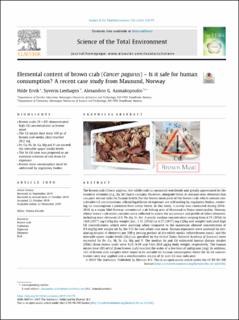| dc.contributor.author | Ervik, Hilde | |
| dc.contributor.author | Lierhagen, Syverin | |
| dc.contributor.author | Asimakopoulos, Alexandros | |
| dc.date.accessioned | 2020-04-17T09:47:56Z | |
| dc.date.available | 2020-04-17T09:47:56Z | |
| dc.date.created | 2019-11-28T00:00:08Z | |
| dc.date.issued | 2019 | |
| dc.identifier.citation | Science of the Total Environment. 2019, . | en_US |
| dc.identifier.issn | 0048-9697 | |
| dc.identifier.uri | https://hdl.handle.net/11250/2651485 | |
| dc.description.abstract | The brown crab (Cancer pagurus; the edible crab) is consumed worldwide and greatly appreciated for the essential elements (e.g., Zn, Se) that it contains. However, alongside these, it contains toxic elements that can pose serious risks for human health. For the brown meat parts of the brown crab, which contain considerable Cd concentrations, official legal limits of exposure are still lacking by regulatory bodies, rendering its consumption a potential food safety threat. In this study, a survey was conducted during 2016–2018 in a major Mid-Norway commercial crab fishing area of Mausund in Frøya municipality, Norway, where brown crab media samples were collected to assess the occurrence and profile of select elements, including toxic elements (Cd, Pb, Hg, Sr, As). A yearly median concentration ranging from 6.75 (2016) to 14.0 (2017) mg Cd/kg dry weight (est.: 2.11 (2016) to 4.37 (2017) mg Cd/kg wet weight) indicated high Cd concentrations, which were alarming when compared to the maximum allowed concentration of 0.5 mg/kg wet weight set by the E.U. for raw white crab meat. Human exposures were assessed by estimating intakes of elements per 100 g serving portion of dry edible media (white/brown meat), and the tolerable upper intake levels (ULs) (as specified by the United States National Academy of Sciences) were exceeded for Fe, Cu, Ni, Se, Ca, Mg and P. The median Se and Cd estimated human dietary intakes (EDIs) (from brown crab) were 8.21–8.59 and 9.64–20.0 μg/kg body weight, respectively. The human intake dose (ID) of Cd (from brown crab) reached the order of a few tens of milligrams (mg). In addition, 33% of brown crab samples were found to be suitable for human consumption when the Se:Cd concentration ratio was applied and a stoichiometric excess of Se over Cd was indicated. | en_US |
| dc.language.iso | eng | en_US |
| dc.publisher | Elsevier | en_US |
| dc.rights | Attribution-NonCommercial-NoDerivatives 4.0 Internasjonal | * |
| dc.rights | Attribution-NonCommercial-NoDerivatives 4.0 Internasjonal | * |
| dc.rights.uri | http://creativecommons.org/licenses/by-nc-nd/4.0/deed.no | * |
| dc.title | Elemental content of brown crab (Cancer pagurus) - Is it safe for human consumption? A recent case study from Mausund, Norway | en_US |
| dc.type | Peer reviewed | en_US |
| dc.type | Journal article | en_US |
| dc.description.version | publishedVersion | en_US |
| dc.source.pagenumber | 8 | en_US |
| dc.source.journal | Science of the Total Environment | en_US |
| dc.identifier.doi | 10.1016/j.scitotenv.2019.135175 | |
| dc.identifier.cristin | 1753433 | |
| dc.description.localcode | (c) 2019 The Author(s). Published by Elsevier B.V. This is an open access article under the CC BY-NC-NDlicense (http://creativecommons.org/licenses/by-nc-nd/4.0/). | en_US |
| cristin.unitcode | 194,67,80,0 | |
| cristin.unitcode | 194,66,25,0 | |
| cristin.unitname | Institutt for lærerutdanning | |
| cristin.unitname | Institutt for kjemi | |
| cristin.ispublished | true | |
| cristin.fulltext | preprint | |
| cristin.qualitycode | 2 | |

